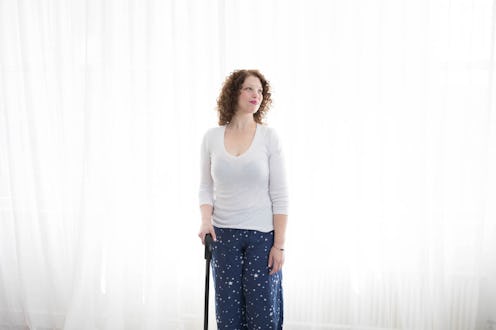Life
How The Sexist Stereotypes We Used To Have About Anxiety Affect Your Healthcare Today

Living with health anxiety — a kind of generalized anxiety disorder that focuses on the fear of becoming ill — is a real, serious issue, but "hypochondria," as it used to be called, is often stigmatized as a symptom of an overactive imagination, or a kind of attention-seeking behavior. Health anxiety or illness anxiety, which can encompass general anxiety as well as somatic symptom disorder, in which symptoms appear without any underlying medical reason, affects people of all genders and ages, and is thought to be experienced by between 1 and 3 percent of the adult population. But throughout history, anxiety, and particularly health anxiety, was viewed through a sexist, stereotypical, and stigmatizing lens: health anxiety was thought of primarily as a women's issue, and one of the potential consequences of that association affects how women get healthcare even today.
Women often face medical bias when seeking help for their health, from medical professionals underestimating their levels of pain to doctors insisting they're making their symptoms up. As many women know, this is not rooted in any proven truth; while women do go to see their doctors more, they also tend to live longer and are more likely to utilize medical services. But the roots of not believing women when they declare that they're in pain are found in some very ancient and profoundly misogynistic ideas.
In ancient Greek medicine, "hypochondria" wasn't thought of as anxiety is today; in fact, it was associated with the abdomen, not the brain. But what's interesting is that in ancient Greece, only men were thought to be afflicted. Psychotherapist Susan Baur, who wrote a history of hypochondria called Hypochondria: Woeful Imaginings, explains that the idea first pops up in the work of the ancient Greek physician Hippocrates, to refer to problems with the region under the ribs. Eventually it became associated with mental states too, in the medieval period, but it was still seen as a problem only for men.
Women, instead, were diagnosed with hysteria, aka a wandering uterus, that caused anxiety, hallucinations, and sexual desire. Hysteria, or "having the vapors" (as it was also thought to be caused by the vapors moving around inside a woman's body), was in many ways identical to hypochondria in men, at least up until the 19th century in Europe. A doctor in 1708 writes of "Hysterical Women and Hypochondriac Men." Hypochondria and melancholy were thought to come from things like "intense thinking" and "too much study" and were believed to be rooted in men's overuse of their rational brains, while women's hysteria was thought to come from their "delicacy" and general nervous weakness. They were also divided by gendered theories about emotions: an 18th century French doctor, Jean-Baptiste Louyer-Villermay, said that men were more inclined to feel ambition and hate, predisposing them to melancholia and hypochondria, while women felt love, making them hysterics. If you're getting astonishingly sexist vibes, you're not wrong.
But then the 19th century happened, and hysteria and hypochondria as categories began to be less gender-specific. The barriers, historians think, broke down because it became more fashionable for both men and women of the upper class to be "sensitive" and "nervous," with people calling it a mark of higher breeding. It was OK to say you were acutely affected by mysterious illnesses, or worried about catching them. Everybody from Dickens to Proust to Edgar Allan Poe to Charlotte Brontë had a reputation for being anxious about their health, or were known to be ill. Hypochondria, historians Barbara Ehrenreich and Deidre English have written, seemed to become a mark of status for rich women in the 19th century. "Boredom and confinement" as part of their everyday lives, they say, meant that women often became part of a "morbid cult of hypochondria or invalidism." This was obviously hugely ableist, erasing the difficult experiences of non-upperclass people with physical disabilities at that time, and giving chronic illness a fashionable aura. Eventually, however, Baur argues, hypochondria crossed class lines and became seen as an illness that was experienced by all, but for a while, it was seen in the public consciousness as exclusively confined to rich women.
The way health anxiety came to be associated with women, with Sigmund Freud theorizing that women made up mental illnesses in particular to attempt to gain "privileges" like attention and space to think, evolved into one form of what we call medical bias today — the systematic disbelieving of women's pain.
Medical bias and the practice of undervaluing or dismissing women's medical complaints is a big deal. It means women can wait long periods for diagnosis for extremely painful conditions like endometriosis, and risk the serious health consequences of underestimated symptoms and untreated issues. And that's not even touching the pretty miserable mental health issues that can be caused by systematically not being believed by doctors. Sexism runs pretty deep in the way we view illness, including anxiety, but the tie between illness anxiety and gender is an entirely illusory one that continues to be damaging to people of all genders today.